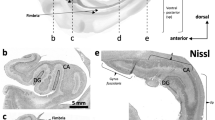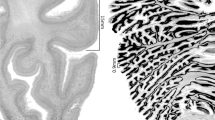Abstract
In the human hippocampus, the pyramidal layer consists of the inferior aspect of the hippocampus which is organized segmentally. Each segment, together with granule layer of the dentate gyrus, exhibits structural unity. In humans, ellipsoidal protrusions called pyramidal hillocks (PHs), which consist of a thick pyramidal cell layer (PL), are present in the inferior aspect of the hippocampus, and are segmentally organized along a longitudinal axis. It is also known that the granule cell layer (GL) of the dentate gyrus (DG) is not a smooth but undulated structure. However, the cytoarchitectural relationships between the protrusions and undulation have yet to be studied well. Here, we aimed to clarify the three-dimensional cytoarchitecture of the PL and GL of human hippocampus. For that purpose, the GL and PL were three-dimensionally reconstructed from serial sections of human hippocampus stained with hematoxylin and eosin. The GL was shaped as tubing with an opening in the dorsal part, and undulated especially in the medial part, forming digit-like processes. In the base of a digit-like process, protrusions of the GL extended laterally, with longer ones reaching the lateral edge, whereas shorter ones disappeared around the medial 1/3 of the GL. Consequently, the lateral part of the GL was undulated loosely. In the ventral view of the PL, the ellipsoidal PHs were sagittally aligned, whereas in the top view, each PH formed an ellipsoidal trough. Each structural unit was formed by a trough of the PH along the bottom, and had a longer GL protrusion in the upper-center, and shorter GL protrusions located between the longer protrusions and the lateral edge of the GL. A digit-like process extended into a dens. It is concluded that a unit of the PH and the GL comprises the longitudinal segmental formation of the hippocampus.









Similar content being viewed by others
Abbreviations
- Alv:
-
Alveus
- CA:
-
Cornu ammonis
- DG:
-
Dentate gyrus
- F:
-
Fimbria
- GL:
-
Granule cell layer
- MRI:
-
Magnetic resonance imaging
- PH:
-
Pyramidal hillock
- PL:
-
Pyramidal cell layer
References
Adler DH, Wisse LEM, Ittyerah R et al (2018) Characterizing the human hippocampus in aging and Alzheimer’s disease using a computational atlas derived from ex vivo MRI and histology. Proc Natl Acad Sci U S A 115(16):4252–4257
Altman J, Das GD (1965) Autoradiographic and histological evidence of postnatal hippocampal neurogenesis in rats. J Comp Neurol 124(3):319–335
Amunts K, Lepage C, Borgeat L et al (2013) BigBrain: an ultrahigh-resolution 3D human brain model. Science 340(6139):1472–1475
Beattie JF, Martin RC, Kana RK et al (2017) Hippocampal dentation: structural variation and its association with episodic memory in healthy adults. Neuropsychologia 101:65–75
Bouchard TP, Malykhin N, Martin WR et al (2008) Age and dementia-associated atrophy predominates in the hippocampal head and amygdala in Parkinson’s disease. Neurobiol Aging 29(7):1027–1039
Bremner JD, Randall P, Scott TM et al (1995) MRI-based measurement of hippocampal volume in patients with combat-related posttraumatic stress disorder. Am J Psychiatry 152(7):973–981
DeKraker J, Lau JC, Ferko KM, Khan AR, Köhler S (2020) Hippocampal subfields revealed through unfolding and unsupervised clustering of laminar and morphological features in 3D BigBrain. Neuroimage 206:116328
Ding SL, Van Hoesen GW (2015) Organization and detailed parcellation of human hippocampal head and body regions based on a combined analysis of cyto- and chemoarchitecture. J Comp Neurol 523(15):2233–2253
Dounavi ME, Mak E, Wells K et al (2020) Volumetric alterations in the hippocampal subfields of subjects at increased risk of dementia. Neurobiol Aging 91:36–44
Du AT, Schuff N, Amend D et al (2001) Magnetic resonance imaging of the entorhinal cortex and hippocampus in mild cognitive impairment and Alzheimer’s disease. J Neurol Neurosurg Psychiatry 71(4):441–447
Duvernoy HM (2005) The human hippocampus: functional anatomy, vascularization and serial sections with MRI. Springer Science & Business Media, Berlin
Erickson KI, Voss MW, Prakash RS et al (2011) Exercise training increases size of hippocampus and improves memory. Proc Natl Acad Sci U S A 108(7):3017–3022
Eriksson PS, Perfilieva E, Björk-Eriksson T et al (1998) Neurogenesis in the adult human hippocampus. Nat Med 4(11):1313–1317
Fitzgerald MJT, Gruener G, Mtui E (2012) Clinical neuroanatomy and neuroscience, 6th edn. Elsevier
Kominami R, Shinohara H, Yasutaka S, Kishibe M (2013) The human hippocampus observed by scanning electron microscopy (SEM): the dentate gyrus is made of an array of the neuronal lamellae. Okajimas Folia Anat Jpn 89:157–164
Ludwig E, Klingler J (1956) Atlas cerebri humani. Karger Publishers, Basel
Malykhin NV, Carter R, Seres P, Coupland NJ (2010) Structural changes in the hippocampus in major depressive disorder: contributions of disease and treatment. J Psychiatry Neurosci 35(5):337–343
Micheli L, Ceccareli M, D’Andrea G, Tirone F (2018) Depression and adult neurogenesis: Positive effects of the antidepressant fluoxetine and of physical exercise. Brain Res Bull 143:181–193
Moser EI, Moser MB, Siegelbaum SA (2021) The Hippocampus and the Neural Basis of Explicit Memory Storage. In: Kandel ER, Koester JD, Mack SH et al (eds) Principles of neural science, 6th edn. McGraw Hill, New York, pp 1339–1369
Müller MJ, Greverus D, Dellani PR et al (2005) Functional implications of hippocampal volume and diffusivity in mild cognitive impairment. Neuroimage 28(4):1033–1042
Nelson MD, Saykin AJ, Flashman LA, Riordan HJ (1998) Hippocampal volume reduction in schizophrenia as assessed by magnetic resonance imaging: a meta-analytic study. Arch Gen Psychiatry 55(5):433–440
Schoenfeld TJ, McCausland HC, Morris HD, Padmanaban V, Cameron HA (2017) Stress and Loss of Adult Neurogenesis Differentially Reduce Hippocampal Volume. Biol Psychiatry 82(12):914–923
Standring S (2020) Gray’s anatomy: the anatomical basis of clinical practice, 42nd edn. Elsevier, Oxford
Velakoulis D, Wood SJ, Wong MT et al (2006) Hippocampal and amygdala volumes according to psychosis stage and diagnosis: A magnetic resonance imaging study of chronic schizophrenia, first-episode psychosis, and ultra-high-risk individuals. Arch Gen Psychiatry 63(2):139–149
Wisse LE, Biessels GJ, Heringa SM et al (2014) Hippocampal subfield volumes at 7T in early Alzheimer’s disease and normal aging. Neurobiol Aging 35(9):2039–2045
Woodward SH, Kaloupek DG, Streeter CC et al (2006) Hippocampal volume, PTSD, and alcoholism in combat veterans. Am J Psychiatry 163(4):674–681
Yasutaka S, Shinohara H, Kominami R (2013) Gross anatomical tractography (GAT) proposed a change from the ‘Two laminae concept’ to the ‘Neuronal unit concept’ on the structure of the human hippocampus. Okajimas Folia Anat Jpn 89:147–156
Acknowledgements
We wish to thank Dr. M. Kagaya (Kanazawa Medical University) for her technical assistance. We sincerely thank those who donated their bodies to science so that anatomical research could be performed. Results from such research can potentially increase mankind’s overall knowledge that can then improve patient care. Therefore, these donors and their families deserve our highest gratitude. This work was supported by JSPS KAKENHI Grant (16K08455 for RK, 19H04212 and 20K21664 for TI), JST FOREST Program (JPMJFR2151 for TI), Toyama Dai-Ichi Bank Scholarship Foundation (TI), and The Ichiro Kanehara Foundation for the Promotion of Medical Sciences and Medical Care (TI).
Author information
Authors and Affiliations
Contributions
Conceptualization: RK HS, TS. Methodology: TS. Formal analysis and investigation: RK, MK, TS. Analysis and interpretation of data: RK, SH, TI. Original draft preparation: RK, SH, TI. Review and editing: MU, SH, TI. Funding acquisition: RK, TI. Supervision: SH, TI. All authors reviewed and edited the final version of the manuscript.
Corresponding author
Ethics declarations
Conflict of interest
The authors declare no conflict of interest.
Additional information
Publisher's Note
Springer Nature remains neutral with regard to jurisdictional claims in published maps and institutional affiliations.
Rights and permissions
About this article
Cite this article
Kominami, R., Sonomura, T., Ito, T. et al. Three-dimensional anatomical structure formed by granule cell layer and pyramidal cell layer in human hippocampus. Anat Sci Int 98, 66–76 (2023). https://doi.org/10.1007/s12565-022-00673-8
Received:
Accepted:
Published:
Issue Date:
DOI: https://doi.org/10.1007/s12565-022-00673-8




